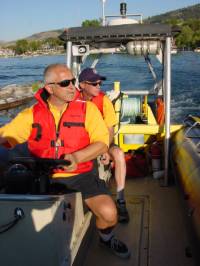
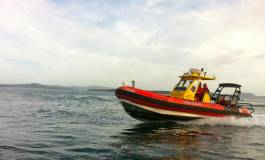
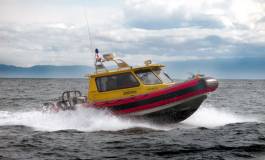
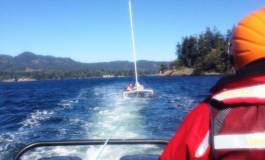
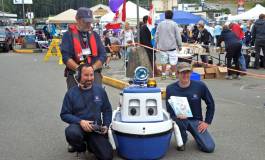
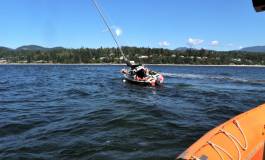
September 22nd, 2005
September 22nd, 2005
OKANAGAN SAFE BOATING PILOT
PROJECT REPORT 23 AUG â€" 06 SEP 2005
AIM:1. To report on Okanagan Safe Boating Pilot Project, that was conducted 23 Aug to 06 Sep 2005 in Vernon, Kelowna and Pentiction.
GENERAL:
2. The Okanagan Safe Boating Pilot Project was a Joint CCGA-Pacific and Transport Canada (including the office of Boating Safety) project designed to deliver Boating Safety messages in a "soft approach" to users of the Okanagan Lake system.
3. The project was conducted with the following:
- Phase 1 (23 â€" 27 August) Thomas Kerr
- Phase 2 (29Aug â€" 02 Sep) David Reese-Thomas, Amarah Gabriel and Ellen Reid
- Phase 3 (02 Sep â€" 06 Sep) Brian Cameron, Sheila Cameron
- A CCGA-Pacific zodiac mark V painted yellow with blue "Boating Safety"on the sides
- Unit 101 South Interior , members from Vernon, Kelowna and Pentiction
- Transport Canada (office of Boating Safety) funding.
4. The project consisted of 2 parts:
- Boat Handling skill development to members of unit 101 (daily inspections, slow operations, including confined turns, docking, going onto plane, trimming as well as being situational aware , conducting SAPs and basic safe boating practices)
- Boating Safety messages delivered as an education and prevention tool
5. The phase 3 session (02-06 Sep) also included a unit meeting and a comprehensive presentation on how this program could fit into the overall existing Boating Safety programs, how to develop a unit training plan and how to prepare for next years activities. (SEE ANNEX A)
TARGET AUDIENCE
6. The Okanagan Lake system includes the following users: sailboats, powerboats, jet skis, houseboats, kayaks, individuals that were water skiing, tubing, fishing, para sailing or just driving fast. It appeared that the lake is occupied with local residents, Albertans (although many had returned prior to the long week end due to early school starts), others that either owned the vessel or rented. Contact was made with stopped vessels on the water, marine and yacht club owners or employees ass well as water related rental companies business owners and employees.
7. Discussions indicated the busiest times on the lake are July and August. The Sep labour day week end is a bit of an anti climax, as the majority of users from Alberta head home for a early school start. Recreational users on the Okanagan Lake system are very fair weather users. During cloudy, rainy or windy days the activity level on the lake is reduced dramatically. Several stories of accidents and incidents involving alcohol, speed and lack of knowledge were readily available by numerous individuals. Although stats are not available at this time, I would suspect that the stats would bear out that this lake, during the summer is extremely dangerous and is in the need for a solid educational program in safe boating practices
RESPONSE:
8. The overall response was extremely positive and enthusiastic. There were several comments throughout the whole timeframe saying that there was a definite need for more boating safety education in the region. The "soft" approach was well received and appreciated.
PROGRAM DELIVERY
9. The program was delivered with 2 things in mind:
- Approach: a soft pro active approach with vessels that were not moving, the emphasis was on education on why certain equipment should be carried, its use and general safe boating practices. Members were identified as auxiliary volunteers that are part of the "Safe Boating Team"
(it was made very clear that this project and the unit would at no time be associated with SAR. The instructions given to the members was that if an incident occurred they were expected to respond as any responsible boater would keeping in mind they are not trained in marine SAR nor is their vessel equipped for such situations. Hence the yellow shirts vice the auxiliary blue shirts )
- Save Boating Messages: which included:
- always wear a PFD and ensure it fits
- learn to swim and use the buddy system
| RSS feed | Feed Description |
|---|---|
| Complete RSS feed | |
| RSS feed for: What´s New | |
| A Rich Site Summary (RSS) feed is an xml data file that provides a summary of the information contained here. It is not designed to be viewed in your browser, but instead by rss reader software. If you do not know what this means - you can safely ignore it, as it is provided for advanced users with rss reader software only. | |
